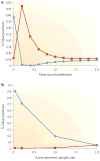Recent and ongoing selection in the human genome
- PMID: 17943193
- PMCID: PMC2933187
- DOI: 10.1038/nrg2187
Recent and ongoing selection in the human genome
Abstract
The recent availability of genome-scale genotyping data has led to the identification of regions of the human genome that seem to have been targeted by selection. These findings have increased our understanding of the evolutionary forces that affect the human genome, have augmented our knowledge of gene function and promise to increase our understanding of the genetic basis of disease. However, inferences of selection are challenged by several confounding factors, especially the complex demographic history of human populations, and concordance between studies is variable. Although such studies will always be associated with some uncertainty, steps can be taken to minimize the effects of confounding factors and improve our interpretation of their findings.
Figures



References
-
- Andolfatto P. Adaptive evolution of non-coding DNA in Drosophila. Nature. 2005;437:1149–1152. - PubMed
-
- Bustamante CD, et al. Natural selection on protein-coding genes in the human genome. Nature. 2005;437:1153–1157. This paper reports a genome-wide scan for selection in humans based on a derivative of the MacDonald–Kreitman test. - PubMed
-
- Sabeti PC, et al. Positive natural selection in the human lineage. Science. 2006;312:1614–1620. This review contains a comprehensive list of genes that are thought to be under selection in humans. - PubMed
Publication types
MeSH terms
Grants and funding
LinkOut - more resources
Full Text Sources
Other Literature Sources

